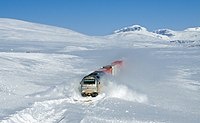
Photo from wikipedia
Abstract. We implement a set of new parameterizations into the widely used Snow, Ice, and Aerosol Radiative (SNICAR) model to account for effects of snow grain shape (spherical vs. nonspherical) and… Click to show full abstract
Abstract. We implement a set of new parameterizations into the widely used Snow, Ice, and Aerosol Radiative (SNICAR) model to account for effects of snow grain shape (spherical vs. nonspherical) and black carbon (BC)–snow mixing state (external vs. internal). We find that nonspherical snow grains lead to higher pure albedo but weaker BC-induced albedo reductions relative to spherical snow grains, while BC–snow internal mixing significantly enhances albedo reductions relative to external mixing. The combination of snow nonsphericity and internal mixing suggests an important interactive effect on BC-induced albedo reduction. Comparisons with observations of clean and BC-contaminated snow albedo show that model simulations accounting for both snow nonsphericity and BC–snow internal mixing perform better than those using the common assumption of spherical snow grains and external mixing. We further apply the updated SNICAR model with comprehensive in situ measurements of BC concentrations in the Tibetan Plateau snowpack to quantify the present-day (2000–2015) BC-induced snow albedo effects from a regional and seasonal perspective. The BC concentrations show distinct and substantial sub-regional and seasonal variations, with higher values in the non-monsoon season and low altitudes. As a result, the BC-induced regional mean snow albedo reductions and surface radiative effects vary by up to an order of magnitude across different sub-regions and seasons, with values of 0.7–30.7 and 1.4–58.4 W m−2 for BC externally mixed with fresh and aged snow spheres, respectively. The BC radiative effects are further complicated by uncertainty in snow grain shape and BC–snow mixing state. BC–snow internal mixing enhances the mean albedo effects over the plateau by 30–60 % relative to external mixing, while nonspherical snow grains decrease the mean albedo effects by up to 31 % relative to spherical grains. Based on this study, extensive measurements and improved model characterization of snow grain shape and aerosol–snow mixing state are urgently needed in order to precisely evaluate BC–snow albedo effects.
Journal Title: Atmospheric Chemistry and Physics
Year Published: 2018
Link to full text (if available)
Share on Social Media: Sign Up to like & get
recommendations!